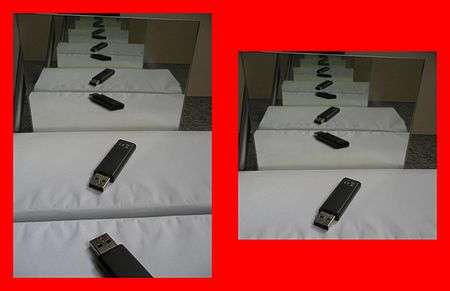Schröder–Bernstein property
A Schröder–Bernstein property is any mathematical property that matches the following pattern
- If, for some mathematical objects X and Y, both X is similar to a part of Y and Y is similar to a part of X then X and Y are similar (to each other).
The name Schröder–Bernstein (or Cantor–Schröder–Bernstein, or Cantor–Bernstein) property is in analogy to the theorem of the same name (from set theory).
Schröder–Bernstein properties
 | ||
| Mirror-in-mirror images as counterexample: The left image can be embedded into the right one and vice versa (below, left/mid); yet, both aren't similar. The Schröder-Bernstein theorem applied to the unstructured pixel sets obtains a non-continuous bijection (right). | ||
 |
 |
 |
In order to define a specific Schröder–Bernstein property one should decide
- what kind of mathematical objects are X and Y,
- what is meant by "a part",
- what is meant by "similar".
In the classical (Cantor–)Schröder–Bernstein theorem,
- objects are sets (maybe infinite),
- "a part" is interpreted as a subset,
- "similar" is interpreted as equinumerous.
Not all statements of this form are true. For example, assume that
- objects are triangles,
- "a part" means a triangle inside the given triangle,
- "similar" is interpreted as usual in elementary geometry: triangles related by a dilation (in other words, "triangles with the same shape up to a scale factor", or equivalently "triangles with the same angles").
Then the statement fails badly: every triangle X evidently is similar to some triangle inside Y, and the other way round; however, X and Y need not be similar.
A Schröder–Bernstein property is a joint property of
- a class of objects,
- a binary relation "be a part of",
- a binary relation "be similar to" (similarity).
Instead of the relation "be a part of" one may use a binary relation "be embeddable into" (embeddability) interpreted as "be similar to some part of". Then a Schröder–Bernstein property takes the following form.
- If X is embeddable into Y and Y is embeddable into X then X and Y are similar.
The same in the language of category theory:
- If objects X, Y are such that X injects into Y (more formally, there exists a monomorphism from X to Y) and also Y injects into X then X and Y are isomorphic (more formally, there exists an isomorphism from X to Y).
The relation "injects into" is a preorder (that is, a reflexive and transitive relation), and "be isomorphic" is an equivalence relation. Also embeddability is usually a preorder, and similarity is usually an equivalence relation (which is natural, but not provable in the absence of formal definitions). Generally, a preorder leads to an equivalence relation and a partial order between the corresponding equivalence classes. The Schröder–Bernstein property claims that the embeddability preorder (assuming that it is a preorder) leads to the similarity equivalence relation, and a partial order (not just preorder) between classes of similar objects.
Schröder–Bernstein problems and Schröder–Bernstein theorems
The problem of deciding whether a Schröder–Bernstein property (for a given class and two relations) holds or not, is called a Schröder–Bernstein problem. A theorem that states a Schröder–Bernstein property (for a given class and two relations), thus solving the Schröder–Bernstein problem in the affirmative, is called a Schröder–Bernstein theorem (for the given class and two relations), not to be confused with the classical (Cantor–)Schröder–Bernstein theorem mentioned above.
The Schröder–Bernstein theorem for measurable spaces[1] states the Schröder–Bernstein property for the following case:
- objects are measurable spaces,
- "a part" is interpreted as a measurable subset treated as a measurable space,
- "similar" is interpreted as isomorphic.
In the Schröder–Bernstein theorem for operator algebras,[2]
- objects are projections in a given von Neumann algebra;
- "a part" is interpreted as a subprojection (that is, E is a part of F if F – E is a projection);
- "E is similar to F" means that E and F are the initial and final projections of some partial isometry in the algebra (that is, E = V*V and F = VV* for some V in the algebra).
Taking into account that commutative von Neumann algebras are closely related to measurable spaces,[3] one may say that the Schröder–Bernstein theorem for operator algebras is in some sense a noncommutative counterpart of the Schröder–Bernstein theorem for measurable spaces.
The Myhill isomorphism theorem can be viewed as a Schröder–Bernstein theorem in computability theory.
Banach spaces violate the Schröder–Bernstein property;[4][5] here
- objects are Banach spaces,
- "a part" is interpreted as a subspace[4] or a complemented subspace,[5]
- "similar" is interpreted as linearly homeomorphic.
Many other Schröder–Bernstein problems related to various spaces and algebraic structures (groups, rings, fields etc.) are discussed by informal groups of mathematicians (see External Links below).
Notes
- Srivastava 1998, see Proposition 3.3.6 (on page 96), and the first paragraph of Section 3.3 (on page 94).
- Kadison & Ringrose 1986, see Proposition 6.2.4 (on page 406).
- Kadison & Ringrose 1986, see Theorem 9.4.1 (on page 666).
- Casazza 1989
- Gowers 1996
See also
- Commutative von Neumann algebras
References
- This article incorporates material from the Citizendium article "Schröder–Bernstein property", which is licensed under the Creative Commons Attribution-ShareAlike 3.0 Unported License but not under the GFDL.
- Srivastava, S.M. (1998), A Course on Borel Sets, Springer, ISBN 0-387-98412-7.
- Kadison, Richard V.; Ringrose, John R. (1986), Fundamentals of the theory of operator algebras, II, Academic Press, ISBN 0-12-393302-1.
- Gowers, W.T. (1996), "A solution to the Schroeder–Bernstein problem for Banach spaces", Bull. London Math. Soc., 28: 297–304, doi:10.1112/blms/28.3.297, hdl:10338.dmlcz/127757.
- Casazza, P.G. (1989), "The Schroeder–Bernstein property for Banach spaces", Contemp. Math., 85: 61–78, doi:10.1090/conm/085/983381, MR 0983381.
External links
- Theme and variations: Schroeder-Bernstein - Various Schröder–Bernstein problems are discussed in a group blog by 8 recent Berkeley mathematics Ph.D.
- When does Cantor Bernstein hold? - "Mathoverflow" discusses the question in terms of category theory: "Can we characterize Cantor-Bernsteiness in terms of other categorical properties?"